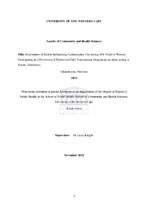| dc.contributor.advisor | Knight, Lucia | |
| dc.contributor.author | Chandiwana, Precious | |
| dc.date.accessioned | 2017-07-19T14:05:48Z | |
| dc.date.available | 2017-07-19T14:05:48Z | |
| dc.date.issued | 2016 | |
| dc.identifier.uri | http://hdl.handle.net/11394/5500 | |
| dc.description | Magister Public Health - MPH | en_US |
| dc.description.abstract | Dual protection is protection against unwanted pregnancy, HIV and other sexually
transmitted infections and a means of achieving safer sex and birth control (WHO, 2012). It is one of the essential tools promoted by the WHO for preventing unintended pregnancies and sexual transmitted infections among HIV-positive women to reduce dual risk of unintended pregnancies, re-infections and transmission of HIV in the cases of sero-discordant couples. However, the use of dual method use among HIV-positive women in Zimbabwe is poorly described. Hence to fill in the existing research gap, this study aims to explore the factors
influencing dual protection use by HIV- positive women participating in a prevention of mother-to-child transmission (PMTCT) program in an urban setting in Zimbabwe.
Methodology:
A qualitative exploratory study design with a combination of qualitative research methods including interviews and focus group discussions was conducted. A total of five focus group discussions (FGDs) each consisting of 8-12 participants was conducted with a total of 51 women. Five in-depth interviews were conducted with key informants. All interviews and FGDs were audio recorded using a digital voice recorder. The interviews were conducted in Shona and translated into English. Data analysis was done manually using thematic coding. Codes emerged from the data using an inductive approach. Ethical principles of research and rigour were observed throughout the study.
Results:
Dual protection use was low among the HIV-positive women. Absolutely non-use of
contraceptive was reported by some women. The main methods of contraceptives were the pill, depo provera and condoms. Inconsistent condom use was mentioned among the few women who reported using condoms. Many barriers to contraceptives use among HIV-positive women in Zimbabwe were identified. However there were a few facilitating factors too. Health system factors associated with health care workers (HCWs) related factors and service delivery processes were reported as major barriers to contraceptive use. Women expressed negative attitude towards condom use associating them with unfaithfulness. Facilitators of contraceptive use identified were couples' HIV testing and counselling, women's increase in CD4 count result, fear of vertical transmission and HIV sero-discordance
between couples.
Conclusion and Recommendations:
In conclusion, dual protection use among HIV-positive women in this community was low. Health system factors were the main barriers to contraceptives use whilst health related factors were the main facilitators. HIV-positive women still face challenges in accessing and utilisation of contraceptives. Hence the barriers to contraceptive use needs to be addressed at the same time promoting the facilitators. | en_US |
| dc.language.iso | en | en_US |
| dc.publisher | University of the Western Cape | en_US |
| dc.subject | Prevention of Mother-to-Child Transmission (PMTCT) of HIV | en_US |
| dc.subject | Contraceptives | en_US |
| dc.subject | HIV-positive women | en_US |
| dc.subject | Reproductive health | en_US |
| dc.subject | Unintended pregnancy | en_US |
| dc.subject | Zimbabwe | en_US |
| dc.title | Exploration of factors influencing contraceptive use among HIV-positive women participating in a Prevention of Mother-to-Child Transmission program in an urban setting in Harare, Zimbabwe | en_US |
| dc.rights.holder | University of the Western Cape | en_US |

